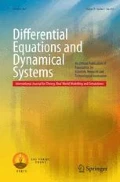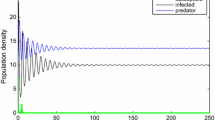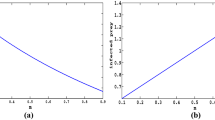Abstract
This paper deals with predator-prey-pathogen interaction where predator influences the transmission rate of the infection in its prey. It is assumed that predator consumes infected prey only. The main results address the existence of interior equilibrium point and its stability. Also we derive the condition for persistence of the system. Bifurcation at the coexistence equilibrium point is established. Lastly, the condition for non-existence of closed orbits is found. Some numerical simulations illustrate the obtained results.





Similar content being viewed by others
References
Morozov, AYu.: Revealing the role of predator-dependent disease transmission in the epidemiology of a wildlife infection: a model study. Theor. Ecol. (2011). doi:10.1007/s12080-011-0142-0
Holt, R.D., Roy, M.: Predation can increase the prevalence of infectious disease. Am. Nat. 169, 690–699 (2007)
Packer, C., Holt, R.D., Hudson, P.J., Lafferty, K.D., Dobson, A.P.: Keeping the herds healthy and alert: implications of predator control for infectious disease. Ecol. Lett. 6, 797–802 (2003)
Freedman, H.I., Waltman, P.: Persistence in models of three interacting predator-prey populations. Math. Biosci. 68, 213–231 (1984)
Choisy, M., Rohani, P.: Harvesting can increase severity of wildlife disease epidemics. Proc. R. Soc. B. 273, 2025–2034 (2006)
Hawlena, D., Abramsky, Z., Bouskila, A.: Bird predation alters infestation of desert lizards by parasitic mites. Oikos 119, 730–736 (2010)
Hudson, P.J., Dobson, A.P., Newborn, D.: Prevention of population cycles by parasite removal. Science 282, 2256–2258 (1998)
Chattopadhyay, J., Arino, O.: A predator-prey model with disease in the prey. Nonlinear Anal. 36, 747–756 (1999)
Venturino, E.: Epidemics in predator-prey models:disease in the predators. IMA J. Math. Appl. Med. Biol. 19, 185–205 (2002)
Hsieh, Y.H., Hsiao, C.K.: Predator prey model with disease infection in both populations. Math. Med. Biol. 25(3), 247–266 (2008)
Xiao, Y.N., Chen, L.: Modelling and analysis of predator-prey model with disease in the prey. Math. Biosci. 171, 59–82 (2001)
Das, P.K., Kundu, K., Chattopadhyay, J.: A predator prey mathematical model with both the populations affected by diseases. Ecol. Complex. 8(1), 687–708 (2011)
Birkhoff, G., Rota, G.C.: Ordinary Differential Equations. Ginn and Co, Boston (1982)
Mukherjee, D.: Uniform persistence in a generalized prey-predator system with parasite infection. Biosystems 47, 101–112 (1998)
Freedman, H.I.: A model of predator -prey dynamics as modified by the action of a parasite. Math. Biosci. 99, 143–155 (1990)
Mukherjee, D.: Persistence in a prey-predator system with disease in the prey. J. Biol. Syst. 11, 101–112 (2003)
Chattopadhyay, J., Bairagi, N.: Pelicans at risk in Salton Sea—an eco-epidemiological study. Ecol. Model. 136, 102–112 (2001)
Rhodes, C.J., Martin, A.P.: The influence of viral infection on a plankton ecosystem undergoing nutrient enrichment. J Theor. Biol. 265, 225–237 (2010)
Lima, S.L.: Nonlethal effects in the ecology of predator-prey interactions. BioScience 48, 25–34 (1998)
Rigby, M.C., Jokela, J.: Predator avoidance and immune defence: costs and trade-offs in snails. Proc. R Soc. Lond. B. Biol. Sci. 267, 171–176 (2010)
Werner, E.E.: Individual behavior and higher-order species interactions. Am. Nat. 140, S5–S32 (1992)
Thiemann, G.W., Wassersug, R.J.: Patterns and consequences of behavioural responses to predators and parasites in Rana tadpoles. Biol. J. Linn. Soc. 71, 513–528 (2000)
Yin, M., Laforsch, C., Lohr, J.N., Wolinska, J.: Predator-induced defense makes Daphnia more vulnerable of parasites. Evolution 65, 1482–1488 (2011)
Baker, R.L., Smith, B.P.: Conflict between antipredator and antiparasite behaviour in larval damselflies. Oecologia 109, 622–628 (1997)
Gard, T.C., Hallam, T.G.: Persistence in food webs-I. Lotka-Volterra food chains’. Bull. Math. Biol. 41, 285–299 (1979)
McCallum, H., Barlow, N.D., Hone, J.: How should pathogen transmission be modelled? Trends Ecol. Evol. 16, 295–300 (2001)
Hudson, P.J.: Grouse in Space and Time. Game Conservancy Ltd, Fordingbridge, Hampshire (1992)
Murray, D.L., Cary, J.R., Keith, L.B.: Interactive effects of sublethal nematodes and nutritional status on snowshoe hare vulnerability to predation. J. Anim. Ecol. 66, 250–264 (1997)
Li, Y., Muldowney, J.S.: On Bendixson criteria. J. Differ. Equ. 106, 27–39 (1993)
Murray, D.L.: Differential body condition and vulnerability to predation in snowshoe hares. J. Anim. Ecol. 71, 614–625 (2002)
Hutson, V., Law, R.: Permanent coexistence in general models of three interacting species. J. Math. Biol. 21(3), 285–298 (1985)
Hofbauer J.: Saturated equilibria, permanence and stability for ecological systems. In: Groos, L., Hallam, T., Levin, S. (eds.) Mathematical Ecology, Proc. Trieste. World Scientific, Singapore (1986)
Butler, G.J., Freedman, H.I., Waltman, P.: Uniformly persistent systems. Proc. Am. Math. Soc. 96, 425–430 (1986)
Mukherjee, D.: Persistence aspect of a predator-prey model with disease in the prey. Diff. Eqn. Dyn. Syst. 24, 173–188 (2016)
Sen, M., Banerjee, M., Morozov, A.: A generalist predator regulating spread of a wildlife disease: exploring two infection transmission scenarios. Math. Model. Nat. Phenom. 10(2), 74–95 (2015)
Mukherjee, D.: Hopf bifurcation in an eco-epidemic model. Appl. Math. Comput. 217, 2118–2124 (2010)
Acknowledgements
The authors are grateful to the anonymous reviewers for their helpful comments and suggestions for improving the paper.
Author information
Authors and Affiliations
Corresponding author
Rights and permissions
About this article
Cite this article
Maji, C., Kesh, D. & Mukherjee, D. The Effect of Predator Density Dependent Transmission Rate in an Eco-Epidemic Model. Differ Equ Dyn Syst 28, 479–493 (2020). https://doi.org/10.1007/s12591-016-0342-6
Published:
Issue Date:
DOI: https://doi.org/10.1007/s12591-016-0342-6




